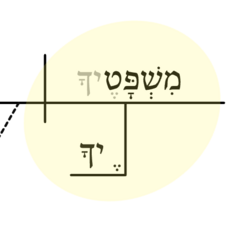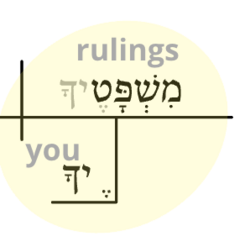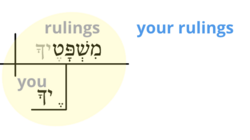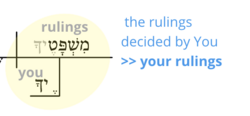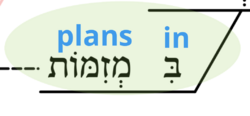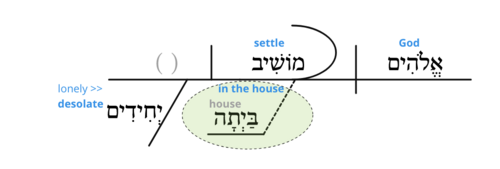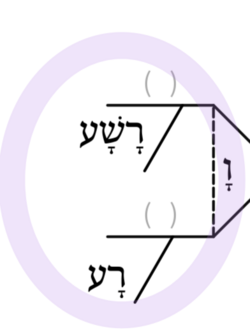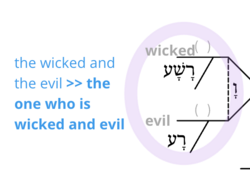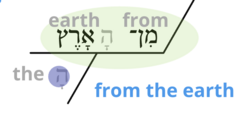Method:Phrase-Level Semantics
- Grammar
- Semantics
- Exegetical Issues
- Discourse
- Poetics
- Synthesis
- Close-but-Clear
- Videos
- Post to wiki
- Style Guide
Introduction
The purpose of Phrase-Level Semantics is to analyze the meaning of units that are higher than the level of the word (Method:Semantics/Lexical Semantics) and lower than the level of the sentence (Semantics/Story behind the Psalm). Specifically, this layer seeks to answer the following questions:
- What is the relationship between each member of a construct phrase?
- What is the function of each preposition?
- What does the definite article or כֹּל ‘all’ tell you about the word to which it is attached?
- Are any of the above noun-phrases idiomatic in Hebrew? If so, how would you communicate it in your language?
- What is the semantic role of each constituent in each sentence?
Steps
1. Setting up your Workspace
Instructions
Copy and paste the phrase-level-semantics template into your workspace. A brief description of each piece of the template is as follows:

- Paste a blank grammatical diagram of the relevant Psalm in frame 1.
- This legend contains the shapes and colours with which you will visualise the various phrasal relationships. Of course, you are encouraged to just copy/paste the shapes and expand/rotate them as needed. The details of the colours are as follows.
- Circle prepositional phrases with a green shaded (colour: #8FD14F; opacity 20%) circle.
- Circle construct chains with a yellow shaded (colour: #FEF445; opacity: 20%) circle.
- For construct phrases within a prepositional phrase, create the shape shown in the template by combining yellow shaded (same colour and opacity as the construct-chain circle) circle with a hollow circle with a green border(same colour and opacity as the prepositional-phrase circle; thickness: 7pts).
- Circle noun-phrases created by phrase-level waws with a hollow circle with a purple border (colour: #BF78F0; thickness:7).
- Highlight all articles with the highlighter tool (colour: #414BB2; thickness: 3/4) #Write out your analyses of construct phrases here in terms of the column headings, the specifics of which are given in step 2 below.
- Write out your analyses of bound/construct phrases here in terms of the column headings, the specifics of which are given in step 2 below.
- Write out your analyses of prepositional phrases here in terms of the column headings, the specifics of which are given in step 3 below.
- Write out your analyses of phrase-level waw here in terms of the column headings, the specifics of which are given in step 4 below.
- Write out your analyses of articles and כֹּל ‘all’ here in terms of the column headings, the specifics of which are given in step 5 below.
- Write out your analyses of semantic roles here in terms of the column headings, the specifics of which are given in step 6 below.
Tools
As much reference material as possible will be provided in the appendices of this guide. But for especially tricky constructions, it will help to have these handbooks handy:
- Gesenius, W. 1909. Hebrew Grammar. Edited by E. Kautzsch. Translated by A.E. Cowley. 28th (German) 2nd (English). Oxford: Claredon Press.
- Jenni, Ernst. 1992. Die Hebräischen Präpositionen Band 1: Die Präposition Beth. Stuttgart: W. Kohlhammer.
- Jenni, Ernst. 1994. Die Hebräischen Präpositionen Band 2: Die Präposition Kaph. Stuttgart: W. Kohlhammer.
- Jenni, Ernst. 2000. Die Hebräischen Präpositionen Band 3: Die Präposition Lamed. Stuttgart: W. Kohlhammer.
- Joüon, Paul S.J., and S.J. Muraoka. 2006. A Grammar of Biblical Hebrew. Subsidia Biblica 27. Rome: Editrice Pontifico Instituto Biblico.
- Merwe, Christo H.J. van der, Jacobus A. Naudé, and Jan H. Kroeze. 2017. A Biblical Hebrew Reference Grammar. 2nd ed. New York: Bloomsbury.
- Waltke, Bruce K., and M. O’Connor. 1990. An Introduction to Biblical Hebrew Syntax. Winona Lake, Indiana: Eisenbrauns.
Workflow
Note that each of the following steps may be broken down into three parts: (a) identifying and circling the construction on the grammatical diagram, (b) analysing the construction in the chart and (c) returning to the grammatical diagram in order to reflect (b) there.
2. Analysing Construct Phrases
Hebrew has a grammatical means of encoding ‘A of B’; this construction can express many different relationships between two (or more) nouns. English grammarians call this construction a ‘Construct’ (our term) or ‘Genitive’ phrase; Hebrew grammarians call it smīḵūt (סְמִיכוּת).
Identify and Circle Construct Phrases
Construct phrases are easy to identify on the grammatical diagram because they all look like stair steps. Circle all these with the appropriate circles by copy/pasting, dragging, and dropping them from 2 above over the construct phrases. Let’s illustrate with a construct phrase from Psalm 10:5.
As mentioned above, we use the yellow shaded circle to mark construct phrases.
After identifying a construct phrase, conduct the semantic analysis in the chart.
Semantic Analysis of Construct Phrases
- In the far left column, simply indicate the verse in question.
- The second column is called ‘Bound phrase’. Here, separate each member of the construct phrase (the stair steps) by an Em-dash ‘—’. Provide only the Hebrew consonants.
- The third column is called ‘Semantic analysis’ because this is where the meaning of the phrase—viz., the relationship between the members involved—is spelled out. In order to determine what this relationship is, first consult the list of construct relationships provided in Appendix A. This may involve narrowing possible relationships down to a few and consulting commentaries/other translations in order to determine the most likely option. After consulting the list, the most likely option for Psalm 10:5 here is product-source. In other words, 'your rulings' here is shorthand for 'the rulings that come from or are given by you'. Represent this in this column by spelling out the semantic relationship as explicitly as possible. Using the labels from appendix A, label the English words that translate the members of the construct phrase. The labels should be (bold and in parenthesis).
- The fourth column is ‘English Translation’. Simply offer a short, idiomatic translation of the previous column. For מִשְׁפָּטֶיךָ, we may translate ‘Your rulings’ or ‘Your laws'.
- In the fifth column, make any notes about difficult issues pertaining to the phrase and document where you found the answer. You can see that for מִשְׁפָּטֶיךָ, a note from the Theological Lexicon of the Old Testament, although it pertains to the lexical semantics, also informs the phrasal semantics. These laws are from the law given by YHWH. The notes column is also the place to cite modern versions (any language) that reflect different interpretations of the construct relationship. You may also cite Hebrew grammars (see above), commentaries, etc.
Represent Semantic Analysis on Grammatical Diagram
Using the words from the ‘English Translation’ column of the chart, label each noun of the phrase appropriately, using a bold grey font (colour: #AAAAAA; size 18).
Note that when labelling a Hebrew pronominal suffix, always use the English oblique case (viz., me, us, you, him, her, it, them). So, for this example, the ‘English Translation’ column in the chart has ' your rulings', but the diagram has you instead of your.
Next, write out the translation from the chart's ‘English Translation’ column next to the phrase in bold blue font (colour: #2D9BF0; size 18).
In some instances, this would be the final step. In others, however, the ‘English translation’ does not (indeed, cannot) adequately capture the semantics of the phrase. This is the case here. It is not clear from ‘your rulings’ that ‘those rulings that come from you’ is meant and not, say, ‘the rulings owned by you’ or something. When this happens, write out a fuller expression of the semantics of the phrase; this will usually be similar to or exactly the same as what you wrote in the chart's ‘semantic analysis’ column. Make sure this fuller description is in non-bold blue font (colour: #2D9BF0; size 18) followed by two right-pointing arrows ‘>>’.
These arrows will be necessary any time it is not immediately clear how one gets from the phrase as it stands in the Hebrew to the meaning reflected in your English translation. The arrows represent the 'steps' you took to get there.
3. Analyzing Prepositional Phrases
Prepositional phrases are easy-but-not-quite-as-easy-as-construct-phrases to spot on the grammatical diagrams. They nearly always (1) sit on a horizontal line connected to a diagonal line and (2) consist of the preposition and its object on the same line separated by a space.
Visual qualities aside, prepositional phrases are identifiable, of course, by the presence of a preposition.
Identify and Circle Prepositional Phrases
As with construct phrases, copy/paste, drag and drop the appropriate circle over a given prepositional phrase. Let's use a phrase from Psalm 10:2 as our example
As mentioned above, use the green shaded circle for prepositional phrases.
Semantic Analysis of Prepositional Phrases
- The verse number goes in the first column.
- Type out the Hebrew consonants of the prepositional phrase in question in the second column.
- In the third column, indicate the ‘semantic role’ marked by that preposition. If need be, consult the resources suggested in Appendix B. For this specific construction, the 'localisation' function of the preposition בְּ, used figuratively, seems right. In other words, the preposition is marking the location where the action of the verb (יתפשו 'may they be caught') is to take place, so בְּ = 'in' here, used figuratively.
- In the fourth column, offer an English translation of the prepositional phrase that would result from your analysis. For the phrase במזמות, this would be 'in (the) plans'.
- Use the fifth column for notes; make sure to site any sources consulted. Here, an observation is recorded that supported the 'localisation' option. According to Jenni, the use of בְּ here is probably motivated by a rhetorical intention to draw a connection between 'plans' here and the 'nets' mentioned in v. 9.
Represent Semantic Analysis on Grammatical Diagram
As in the previous step, use the words from your charts ‘English’ translation columns, in the proper font, to label the members of the phrase.
Note that there was no need here to elaborate on the phrase. 'In' and 'plans' sufficiently reflects the semantics of the phrase. In a situation like this, leave the bold blue font over the Hebrew as shown in this example.
Adverbial accusatives
Adverbial accusatives should also be analyzed at this point in the analysis. Adverbial accusatives are nouns or noun-phrases which function adverbially. They are similar, in this respect, to prepositional phrases. Adverbial accusatives are diagramed just like prepositional phrases, except the slanted line is dashed instead of solid. Adverbial accusatives are also marked, at this layer, in a manner similar to prepositions; they are marked with a green circle, though the green circle has a dashed border.
Include adverbial accusatives in the "prepositional phrase" chart, and analyze them using the same categories which are used for prepositional phrases. See also the list of possible functions in IBHS 10.2.2.
Note: Combined Construct and Prepositional Phrases
As stated above, when a construct chain appears in a prepositional phrase, use a yellow shaded hollow circle with a green border. Observe the following example from Psalm 10:14
Here, the construct phrase ידך ‘your hand’ is nested in a prepositional phase introduced by בְּ. After carrying out a semantic analysis on both the chart for construct phrases and prepositional phrases, represent both analyses with a single phrasal gloss here. Notice the use of the arrows. The first gloss 'in your hands' renders the Hebrew literally. This does not capture the semantics so more 'steps' are needed to get there. The meaning of 'in your hand' is 'in your control.' In the context of the psalm, however, God's control is invoked in order to refer to his care, and so the final phrasal gloss is in your care.
4. Phrase-Level Waw
The conjunction וְ 'and' in Biblical Hebrew can join units of all sizes. Some, therefore, operate on the level of the phrase and must therefore be identified and analysed in this layer.
Identify and Circle all Phrase-Level Waws and their Members
Since waws operate on many levels, identifying this particular waw requires some discernment/interpretation. The prime candidates for this kind of waw are anytime two or more substantives sitting on a forked bracket have waw(s) between them. Here is an example from Psalm 10:15
Semantic Analysis of Phrase-Level Waws
Study the following example, which resembles exactly the analysis component of the previous steps.
Use the list of functions of phrase-level waws provided in Appendix D to guide your analysis.
Represent Analysis on Grammatical Diagram
Follow the same procedures here as the previous steps. Study the following example (still from Psa 10:15).
The noun phrase refers to this type of wicked person with two words, 'wicked' and 'evil'. Literally the text reads '(the) wicked and (the) evil', as written out here in non-bold blue. But this does not accurately represent what the phrase level-waw is doing—creating a list of characteristics about this person. So, the arrows '>>' are used to bring this out clearly.
5. Articles and כֹּל
Generally, definite articles tell you something about the identifiability or the inclusiveness about the word to which the article is attached. The noun כֹּל is a quantifier that tells you about the scope of the word to which it is attached. Spelling out the function of these two items is important for a good understanding of a passage because it gives you a good idea of the status and number of the entit(ies)y in the passage.
Identify all Articles and Instances of כֹּל and Mark the Former
Go through the grammatical diagram and mark every instance of the article with the appropriate highlighter. These are easy to spot because they always sit next to a diagonal line and are written with parentheses (ה). Note: do not highlight all definite words (e.g. proper names, nouns with pronominal suffixes), only the definite article.
Don't worry about marking the כֹּלs. We treat these like nouns in construct and so they get marked with construct phrases, for example:
You will, however, have to analyse them in the chart.
Semantic Analysis of Articles and כֹּל
Use Appendix C to decide the functions of the article as well as the functions of כֹּל.
After looking through Appendix C we notice in Psalm 10:2 that מזמותיו is plural and definite, and so the כֹּל here refers to the totality (not each individual item in that totality, viz., ' each of his plans ') of an identifiable (as opposed to unidentifiable, so not 'all plans) group.
After checking the list of the functions of the definite article, it's evident that word ארץ 'earth' has the article here in Psalm 10:18 because that entity (the earth) is unique. As stated in the 'notes' column, things that are unique, viz., there's only one of them, often receive the article.
Represent Semantic Analysis on Grammatical Diagram
Observe the above examples.
For the definite, article, the semantic analysis in the chart is sufficient. On the grammatical diagram, simply translate as 'the'.
Do reflect your semantic analyses of כֹּל on the diagram. In most cases, this comes down to translating as 'all' vs. 'every'.
6. Semantic Roles
In the final table, identify the semantic role of each constituent in each clause. Each row of the table should contain one complete clause. The verse number should go in the first column; the action or state (usually a verb) should go in the second column; and the remaining constituents should go in the appropriate column depending on their semantic roles. For this table, unlike the previous tables, use English glosses instead of Hebrew text. Use the English glosses which you have chosen for the diagram.
See Appendix E for a definition of each of the semantic roles.
Appendices
Appendix A: Construct Relations
The following list is taken from section §25.4 of van der Merwe et al. (2017, 226–229). You should be able to find all you need here. If not, the relevant sections in the other grammars are: Gesenius §89a, §128g–y; Joüon & Muraoka §129; Waltke & O’Conner §9.4–§9.5
Relationships of Possession
- (1) Possession (concrete object)–possessor
- The house of the king בֵּית הַמֶּלֶךְ
- (2) Possession (body part)–possessor
- The lips of the king שִׂפְתֵי המֶּלֶךְ
- (3) Possession (characteristic)–possessor
- The majesty of the king הַדְרַת־המֶּלֶךְ
- (4) Kinship/relationship–possessor
- The sons of the king בְּנֵי המֶּלֶךְ
- (5) Possessor–possession
- The owner of the house בְּעַל הַבַּיִת
Subject and Object Relations
- (1) Verbal notion–subject
- The blessing of (or, by) the Lord בִּרְכַּת יהוה
- (2) Verbal notion (passive)–agent
- The murdered (ones) of the woman הֲרוּגֵי הָאִשָּׁה
- (3) Verbal notion–object
- The fear of (for) the Lord יִרְאָת יהוה
Partitive Relationships
- (1) Part–divided whole
- The members of (among) the prophet guild בְּנֵי הַנְּבִיאִים
- (2) Superlative part–divided whole
- The best (good) of (among) the sons טוֹב הַבָּנִים
- (3) Specification of undivided whole
- All of the sons כָּל־הַבָּנִים
Equalising Relationships
- (1) Entity–synonym
- Joy of (viz.) rejoicing שִׂמְחַת גִּיל
- (2) Entity–class (genus)
- A fool of (viz.) a person כְּסִיל אָדָם
- (3) Entity–type (species)
- Sacrifices of (viz.) peace offerings זִבְחֵי שְׁלָמִים
- (4) Entity–name
- The river of (viz.) the Euphrates נְהַר פְרָת
- (5) Entity–characteristic (description, attribute, quality)
- Words of (with) insight אִמְרֵי בִינָה
Adverbial Relationships
- (1) Entity–aim, goal or result
- Stones of (meant for) a sling אַבְנֵי־קֶלַע
- (2) Entity–manner
- Riches of (acquired through) injustice אוֹצְרוֹת רֶשַׁע
- (3) Entity–cause or reason
- Exhausted (ones) of (due to) hunger מְזֵי רָעָה
- (4) Entity–means (instrument)
- The wounded (ones) of (by means of) the sword חַלְלֵי־הַחֶרֶב
- (5) Entity–duration of time
- A son of a year בֶּן־שָׁנָה
- (6) Entity–direction
- The (ones) going down (into the) pit יוֹרְדֵי בוֹר
- (7) Entity–origin
- The loot of (from) the cities שְׁלַל הֶעָרִים
Other Relationships
- (1) Product–material
- Vessels of silver כְּלֵי כֶסֶף
- (2) Product–author, creator, source, origin
- The book of (by) the man סֶפֶר הָאִישׁ
- (3) Characteristic–with regard/respect to (specification)
- Foolish of (with respect to) lips אֱוִיל שְׂפָתַיִם
- (4) Entity–interested (favoured/injured) party
- The trap of (for, to the detriment of) a person מוֹקֵשׁ הָאָדָם
- (5) Container–content
- A bag of (full of) water חֵמַת מַיִם
Appendix B: Prepositions
A comprehensive list would be too big for these guidelines. We recommend that you consult one of the following grammars: Gesenius §119g–§119ii; Waltke & O’ Conner §11.2–§11.3; Joüon & Muraoka §133; van der Merwe et. al. §39.2–§39.22. The last of these is probably the most user-friendly in terms of brevity. A word is in order, however, about the possibly difficult terminology employed by this grammar.[1]
Appendix C: Determiners
Functions of the Definite Article
The following list is taken from van der Merwe et al. §24.4.4 unless otherwise noted. If none of these common functions fit, have a look at the following sections: Gesenius §126; Waltke & O’Conner §13.5.1–§13.5.2; Joüon & Muraoka §137f–§137n.
Note that 1–4 are known as the ‘semantic’ uses of the article (the article tells us something about the referent of the word to which it is attached), while 5–8 are ‘syntactic’ uses (the article combines with a noun in order to fill a particular role in the sentence). For the purposes of this visualisation, this distinction does not really matter, but it’s good to be aware.
| Use | Explanation | Example | Comment |
|---|---|---|---|
| Identifiability - unique referent | The article is often used because the thing it’s attached to is the only one of its kind. | הַשֶּׁמֶשׁ ‘The Sun’ | A speaker may expect the hearer to be able to identify the Sun because there is only one Sun in our world. |
| Identifiability - specific referent | The article is used on nouns that have been previously mentioned in a span of text. | וַיִּקַח…בֶן־הַבָּקָר ‘And he took…the calf’ (Gen 18.8). | The reader can identify the calf in question because it was introduced (without an article) in v. 7. |
| Identifiability - implication | The article can mark entities that we may infer are present in a situation (even if not previously mentioned). | וַתּעַר כַּדָּהּ אֶל־הַשֹּׁקֶת ‘And she emptied the jar into the trough’ (Gen 24.20). | The jar has to be emptied somewhere. That somewhere gets the article. |
| Inclusiveness - Class | The article is used to refer to all members of a certain class. | לֹא תואכְלוּ…אֶת־הַגָּמָל ‘Do not eat camels [lit., the camel]’ (Lev. 11.5). | No specific camel is in view here. Rather, all things that belong to the class ‘camel’. |
| Demonstrative | The article ‘points’ to something, especially time. | הַיוֹם ‘Today’ [lit. ‘the day’] (Gen. 4.14). | |
| Vocative | The article can combine with an addressee in order to express a vocative. | חֵי נַּפְשְׁךָ הַמֶּלֶךְ ‘As surely as you live, O King’ (1 Sam 24.9) | |
| Relative Marker | The article can combine with a word—most commonly a participle—in order to mark the beginning of a relative clause. | לַיהוה הַנִּרְאֶה אֵלָיו ‘To the Lord, who had appeared to him’ (Gen 12.7). | |
| Superlative | The article + predicative adjective is one strategy used in Hebrew for the superlative. | כִּי־אַתֶּם הַמְעַט מִכָּל־הָעַמִּים ‘You are the fewest of all the people’ (Deut. 7.7). |
Functions of כֹּל
The noun כֹּל ‘all’ is used as a quantifier. Quantifiers specify the number of entities that satisfy the referent to which it is attached. The meaning of כֹּל depends on the definiteness and number of the noun to which it is attached. You will generally choose from the following four options, taken from van der Merwe et. al. (2017, 309–310)
With a singular and indefinite noun, כֹּל can be glossed ‘each; every individual’. That is the reference is to each discrete entity within an unidentifiable whole.[2] So in the following example, God feels indignation each individual day for an unspecified length of time.
וְאֵ֗ל זֹעֵ֥ם בְּכָל־יֽוֹם׃
A God who feels indignation each/every day (Psa. 7.12)
With a plural and indefinite noun; כֹּל means ‘all; each and every one’. That is, the reference is to an unidentifiable whole that, of course, is composed of individual items.[3] In the following example, notice that the verb is plural, because the reference is to the many tables that make up the unspecified whole.
כִּי כָּל־שֻׁלְחָנ֔וֹת מָלְא֖וּ קִ֣יא צֹאָ֑ה
All tables are filled with filthy vomit (Isa 28:8).
With a singular and definite noun; כֹּל can be glossed ‘all’. That is, the reference is to every member of an identifiable group. In the following example, Qohelet tells us each member of the group identifiable via common knowledge ‘mankind’ should eat, drink and be merry.
וְגַ֤ם כָּל־הָאָדָם֙ שֶׁיֹּאכַ֣ל וְשָׁתָ֔ה וְרָאָ֥ה ט֖וֹב בְּכָל־עֲמָל֑וֹ
And also all mankind should eat and drink and see good in all of his toil (Eccl. 3:13)
With a plural and definite noun; כֹּל can be glossed ‘all’. That is, the reference is to the totality of an identifiable group. In the following example, we find out the sum total of all the temple servants just listed. The temple servants are identifiable (they have the definite article) because they were previously mentioned in the text (v. 43).
כָּ֨ל־הַנְּתִינִ֔ים וּבְנֵ֖י עַבְדֵ֣י שְׁלֹמֹ֑ה שְׁלֹ֥שׁ מֵא֖וֹת תִּשְׁעִ֥ים וּשְׁנָֽיִם׃
All (the total) of the temple servants and the sons of Solomon’s servants—392 (Ezra 2:58).
Appendix D: Waw
The various functions of phrase-level waw are as follows.[4]
1. Every entity (#a), groups of entities (#b) or only the last entity in the list (#c) to be added, is preceded by וְ. In negated clauses or conditional clauses, a list of “apparent” alternatives may be involved (#d).
| a | כִּ֤י אָֽנֹכִי֙ נָתַ֣תִּי לָ֔הּ הַדָּגָ֖ן וְהַתִּיר֣וֹשׁ וְהַיִּצְהָ֑ר | that it was I who gave her the grain, the wine [lit. and the wine], and the oil (Hos. 2:10) |
| b | נֹתְנֵ֤י לַחְמִי֙ וּמֵימַ֔י צַמְרִ֣י וּפִשְׁתִּ֔י שַׁמְנִ֖י וְשִׁקּוּיָֽי | who give (me) my bread and my water, my wool and my flax, my oil and my drink (Hos. 2:7) |
| c | כָּל־מְשׂוֹשָׂ֔הּ חַגָּ֖הּ חָדְשָׁ֣הּ וְשַׁבַּתָּ֑הּ | all her mirth, her feast(s), her new moon(s) and her sabbath(s) (Hos. 2:13) |
| d | לֹֽ֣א־תַעֲשֶׂ֣֨ה כָל־מְלָאכָ֡֜ה אַתָּ֣ה ׀ וּבִנְךָֽ֣־וּ֠בִתֶּ֗ךָ עַבְדְּךָ֤֨ וַאֲמָֽתְךָ֜֙ וּבְהֶמְתֶּ֔֗ךָ וְגֵרְךָ֖֙ אֲשֶׁ֥֣ר בִּשְׁעָרֶֽ֔יךָ | You shall not do any work, you, or your son, or your daughter, you manservant, or your maidsevant, or your cattle, or the sojourner who is within your gates (Exod. 20:10). |
Sometimes (#e) the phrases to be coordinated by וְ are split (called split coordination).
| e | וְעָבְד֤וּ אֹתוֹ֙ כָּל־הַגּוֹיִ֔ם וְאֶת־בְּנ֖וֹ וְאֶֽת־בֶּן־בְּנ֑וֹ | And they shall serve him, all the nations, and his son and the son of his son (Jer. 27:7). |
Sometimes (#f) two words form a type of fixed compound. (If the word that is preceded by וְ is short then וָ is used instead of וְ.)
| f | ט֣וֹב וָרָ֔ע | good and evil (Gen. 2:17) |
2. Sometimes both the first and the second entity of a coordinated phrase are preceded by וְ. It is then regarded as a correlative conjunction.
| וּבְיִשְׂרָאֵ֖ל וּבָֽאָדָ֑ם | both in Israel and among all humankind (Jer. 32:20). |
3. An apparently superfluous use of וְ (rare).
| וַתֵּ֤שֶׁב תָּמָר֙ וְשֹׁ֣מֵמָ֔ה בֵּ֖ית אַבְשָׁל֥וֹם אָחִֽיהָ׃ | So Tamar, [lit. and] a desolate woman, dwelt in the house of Absalom, her brother (2 Sam. 13:20). |
Appendix E: Semantic roles
- Agent: causer or initiator of events
- Experiencer: animate entity which perceivers a stimulus or registers a particular mental or emotional process or state
- Recipient: animate entity which receives or acquires something
- Beneficiary: entity (usually animate) for whose benefit an action is performed
- Instrument: inanimate entity used by an agent to perform some action
- Theme: entity which undergoes a change of location of possession, or whose location is being specified
- Patient: entity which is acted upon, affected, or created; or of which a state or change of state is predicated
- Stimulus: object of perception, cognition, or emotion; entity which is seen, heard, known, loved, remembered, hated, etc.
- Location: spatial reference point of the event
- Source: the origin or beginning point of a motion
- Goal: the destination of end-point of a motion
Notes
- ↑ Van der Merwe et. al. use the language of ‘landmark’ and ‘trajector’ to describe the relationship between the entities on either side of a preposition. The two terms are used in an attempt to capture the idea that in any given scenario involving two entities, one is ‘doing’ something (trajector) while the other is relatively stationary (landmark). So in the sentence ‘The lamp is under the table’, ‘lamp’ is the trajector because it is the entity doing the ‘being underneath’ something. Of course, neither entity is moving, but in the way the scenario is verbalised, the lamp is the more ‘dynamic’ of the two since it is actually ‘doing’ something (viz., being under a table). Operationally, in most cases, what comes after the preposition (‘under’ in the above example) is the landmark, and the trajector is usually the subject of the verb that the preposition is modifying. Note that, in van der Merwe et. al.’s grammar, the trajector may be a verbal idea. Thus of לַחֲמוּ בְלַחֲמִי ‘eat of my bread’ (Prov 9.5), the grammar states ‘the focus of trajector x = בְּ landmark y is not x as an entity separated from y, but x as a part of the bigger entity y’ (339). In other words, the trajector is the verbal idea ‘eating’ because it is figuratively ‘doing’ something, viz., making contact with (בְּ) part of the bread (לחמי). Remember when using this grammar that the landmark is usually the unit that comes after the preposition.
- ↑ In technical jargon, this is a distributive quantifier with the nuance of individualisation.
- ↑ In (yet more) technical jargon, this is a distributive quantifier without the nuance of individualisation.
- ↑ The following list is copied from Van der Merwe et. al. (2017, 419–420).
